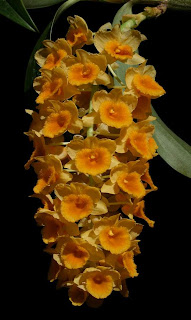
Arachnis Maggie Oei 'Red Ribbon', a hybrid

Arachnis flos-aeris var. insignis, the storied "Black Orchid" is, in truth, deep red
 Arachnis Maggie Oei 'Yellow Ribbon" An extremely hardy and common plant in PR
Arachnis Maggie Oei 'Yellow Ribbon" An extremely hardy and common plant in PR
A Vandachnis Coronation is a hybrid of Vandopsis lissochiloides x Arachnis Maggie Oei. It is a slow growing, large sized plant that blooms once a week and produces long lasting leathery flowers that favor the Arachnis parent.
Because of their ecology Arachnis plants can be difficult to culture and bloom if certain things are not done.
1. An Arachnis plant needs a good root system to grow and bloom well and to survive the effects of full sunlight. A young plant with few roots that is grown exposed to full sunlight will grow very slowly and if it blooms it will bloom weakly. So you need to keep the base in the shade in a pot filled with bark and leafmold. A touch of cattle manure can do wonders.
2. You have to replicate the plant's journey to the canopy, this is done by tying the plant to a suitably sturdy post, this should be positioned so that the plant eventually reaches a spot where it is receiving full sun during most of the day.
3. When the plant has reached a height that has the tip of the stem receiving full sun and has started blooming, allow it to grow about two feet more and then bend (but not break) the stalk to the side. The bent stalk will mimic what happens to plants that protrude too much from the canopy. The bent tip will continue growing and blooming albeit not as vigorously as before. But after the tip of the stalk is bent you will notice a new stem growing just under the spot where you bent the stem. Continue bending down new stems and cutting the tips that are blooming too poorly. Plant them near the base of the first plant.
4. Continue planting stems and enjoying the results, give stem props to neighbors so that they can plant their own plants.
5. Enjoy the ever enlarging mass of Arachnis that is decorating your house and your neighbors house.
6. Start getting nervous and paranoid about the sheer mass of orchids that is now growing all around your county. You know they are talking about you.
7. Grab a machete and your loved ones and hack your way out to freedom away from the encroaching ever growing orchids.
8. Flee the country.
9. In your new residence buy an innocuous looking "fast growing"orchid.























 The Sierra Palm forest, habitat of this orchid
The Sierra Palm forest, habitat of this orchid





























